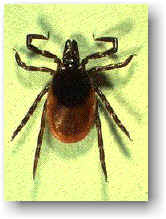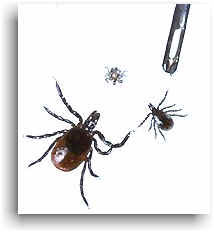Lyme Disease

BNL has the three closely interrelated elements that must be present in the natural environment for Lyme disease to exist in the area: animals that carry Lyme disease bacteria, ticks that transmit the bacteria, and mammals (such as mice and deer) that provide food for the ticks in their various life stages.
Lyme disease was first recognized in the United States in 1975, after a mysterious outbreak of arthritis near Lyme, Connecticut. Since then, reports of Lyme disease have increased dramatically, and the disease has become an important public health problem in some areas of the United States.
Lyme disease is an infection caused by the corkscrew-shaped bacterium Borrelia burgdorferi, a member of the family of spirochetes. The bite of ticks spreads the bacterium that causes Lyme disease. The black-legged (or deer) tick, Ixodes scapularis, which normally feeds on the white-footed mouse, the white-tailed deer, others mammals, and birds, is responsible for transmitting Lyme disease bacteria to humans in the northeastern and northcentral United States. On the Pacific Coast, the Lyme disease bacteria are transmitted to humans by the western black-legged tick, Ixodes pacificus, and in the southeastern states, possibly by the black-legged tick, Ixodes scapularis.
Ixodes ticks are much smaller than the common dog and cattle ticks. In their larval and nymphal stages, they are no bigger than the eye of a common sewing needle. Adult ticks are larger, about the size of a small apple seed.

Nymphal ticks are the primary source for transmitting Lyme disease bacteria to humans, probably because nymphs are more likely to feed on people and are rarely noticed because they are tiny (less than 2mm). Thus, nymphs have the necessary time to feed and transmit the bacteria, typically after feeding for 2 or more days. Also, nymphal ticks feed during the spring and summer months when people spend the most time outdoors.
Adult ticks can also transmit the bacteria, but because adult ticks are larger and more noticeable, they are more likely to be removed from a person’s body within a few hours, and therefore are less likely to have sufficient time to transmit the bacteria. Moreover, adult Ixodes ticks are most active during the cooler months of the years, when people spend less time outdoors and additional clothing may provide added protection.
Personal protection from tick bites
You can decrease the chances of being bitten by a tick by following a few precautions.
- Avoid tick-infested areas, especially in May, June and July (many local health departments and park or extension services have information on the local distribution of ticks).
- Wear light-colored clothing so that it is easier to spot ticks.
- Tuck pant legs into socks or boots and shirt into pants.
- Tape the area where pants and socks meet
so that ticks cannot crawl under clothing.
- Wear a long-sleeved shirt and pants instead of shorts for added protection.
- Spray insect repellent containing a 20-30% concentration of DEET on clothes and on exposed skin other than the face, or treat clothes (especially pants, socks, and shoes) with permethrin, which kills ticks on contact.
- Walk in the center of trails to avoid contact with overgrown grass and brush at trail edges.
- After being outdoors, remove your clothing and wash and dry it at high temperature.
- Inspect your body carefully and remove attached ticks.
This can be done with tweezers, grasping the tick as close
to the skin surface as possible and pulling straight back
with a slow steady force. Avoid crushing the tick's body.
- Use insect repellants such as Bio-Spot on dogs accompanying you out doors to prevents tours pets from bringing tides indoors
For detail information on Lyme disease contact the Centers for Disease Control and Prevention


